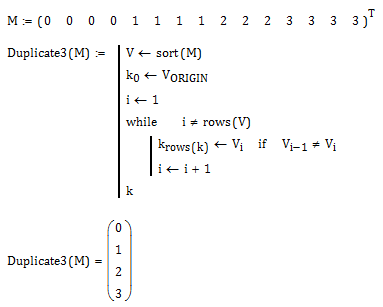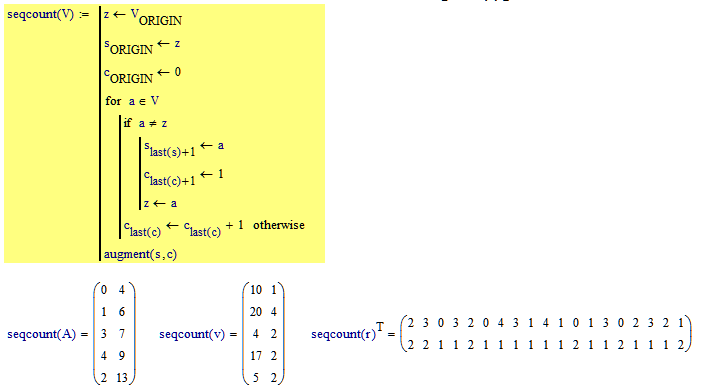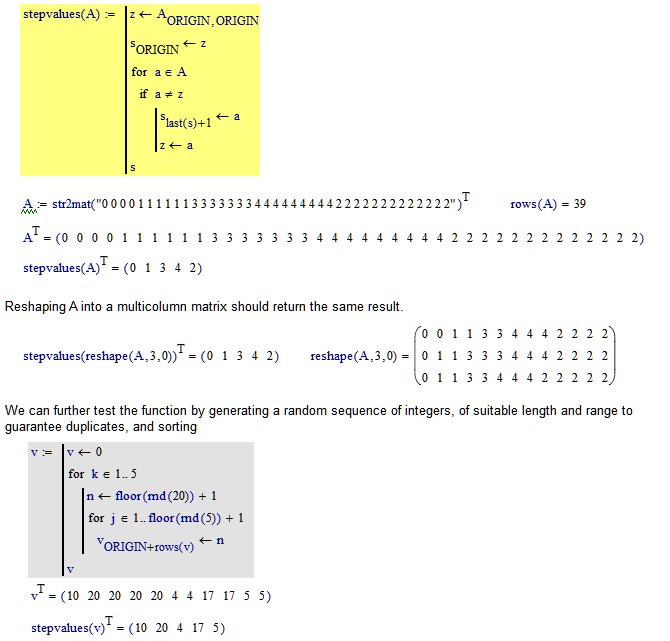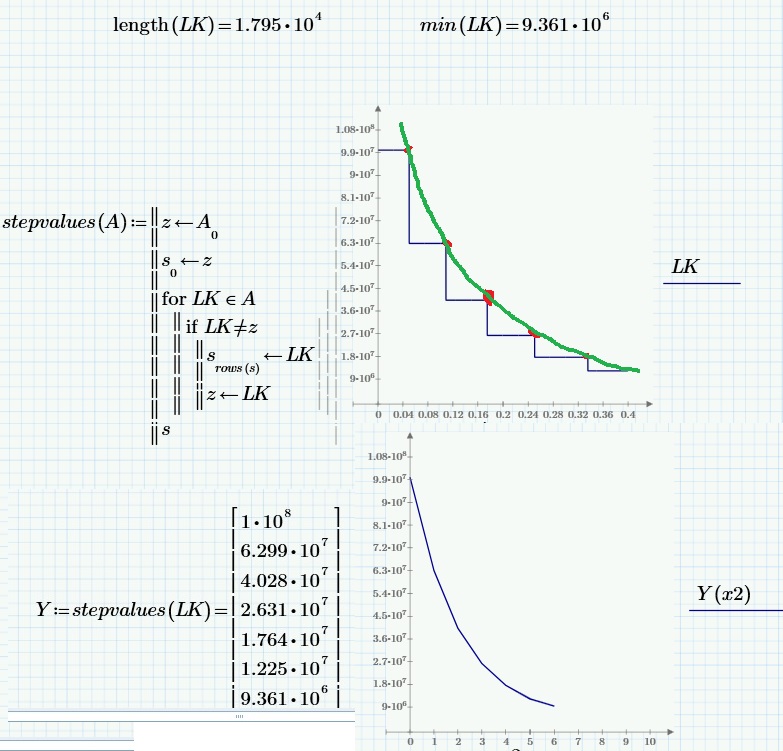Community Tip - Visit the PTCooler (the community lounge) to get to know your fellow community members and check out some of Dale's Friday Humor posts! X
- Subscribe to RSS Feed
- Mark Topic as New
- Mark Topic as Read
- Float this Topic for Current User
- Bookmark
- Subscribe
- Mute
- Printer Friendly Page
return an array from another array
- Mark as New
- Bookmark
- Subscribe
- Mute
- Subscribe to RSS Feed
- Permalink
- Notify Moderator
return an array from another array
Hello everyone,
I have a question from extracting an array.
Suppose I have an array A=[0 0 0 0 1 1 1 1 1 1 3 3 3 3 3 3 3 4 4 4 4 4 4 4 4 4 2 2 2 2 2 2 2 2 2 2 2 2 2]
How can I extract a subarray B=[0 1 3 4 2]
I am new to mathcad. Thank you for your help in advance.
Son
Solved! Go to Solution.
- Labels:
-
Other
Accepted Solutions
- Mark as New
- Bookmark
- Subscribe
- Mute
- Subscribe to RSS Feed
- Permalink
- Notify Moderator
NGUYEN Van Son wrote:
Hello everyone,
I have a question from extracting an array.
Suppose I have an array A=[0 0 0 0 1 1 1 1 1 1 3 3 3 3 3 3 3 4 4 4 4 4 4 4 4 4 2 2 2 2 2 2 2 2 2 2 2 2 2]
How can I extract a subarray B=[0 1 3 4 2]
I am new to mathcad. Thank you for your help in advance.
With a bit of programming.

Stuart
- Mark as New
- Bookmark
- Subscribe
- Mute
- Subscribe to RSS Feed
- Permalink
- Notify Moderator
NGUYEN Van Son wrote:
Hello everyone,
I have a question from extracting an array.
Suppose I have an array A=[0 0 0 0 1 1 1 1 1 1 3 3 3 3 3 3 3 4 4 4 4 4 4 4 4 4 2 2 2 2 2 2 2 2 2 2 2 2 2]
How can I extract a subarray B=[0 1 3 4 2]
I am new to mathcad. Thank you for your help in advance.
With a bit of programming.

Stuart
- Mark as New
- Bookmark
- Subscribe
- Mute
- Subscribe to RSS Feed
- Permalink
- Notify Moderator
Slight alternative to Stuarts method using a while loop.

Mike
- Mark as New
- Bookmark
- Subscribe
- Mute
- Subscribe to RSS Feed
- Permalink
- Notify Moderator
hello Mike,
Thank you very much for your response.
Are the elements of array: Duplicate3(M)=(0 1 2 3) taken from the last value (I underlined below) of each similar sequence? or arbitrary?
M:= (0 0 0 0 1 1 1 1 2 2 2 3 3 3 3 3 3)
If no, how can we know that?
And is the commande V<-- sort(M) is used to sort M?
If yes, I dont need this because I want an array randomly , like N:=(0 0 0 8 8 8 8 10 10 10 5 5 5 5 5 5 1 1 1 1 1 1 1 )
Thank you very much,
NGUYEN
- Mark as New
- Bookmark
- Subscribe
- Mute
- Subscribe to RSS Feed
- Permalink
- Notify Moderator
NGUYEN Van Son wrote:
...And is the commande V<-- sort(M) is used to sort M?
If yes, I dont need this because I want an array randomly , like N:=(0 0 0 8 8 8 8 10 10 10 5 5 5 5 5 5 1 1 1 1 1 1 1 )
Then you may want an approach something like the attached to get the replicated/singleton partition.

The problem with result this is that you have lost the ordering information. If you want to retain the ordering but keep track of the sequence lengths, then something like this may be of use (based on my setcount function).

Stuart
- Mark as New
- Bookmark
- Subscribe
- Mute
- Subscribe to RSS Feed
- Permalink
- Notify Moderator
Mike Armstrong wrote:
Slight alternative to Stuarts method using a while loop.
Mike
I notice you've got ORIGIN as the index of the first element of V; you can simplify it by just setting the index to 0. Unfortunately, the rows trick for autoincrementing the row index doesn't work with an arbitrary ORIGIN. Here's a variant of my original function that seems to be ORIGIN independent and the works over a 2D matrix (assuming standard Mathcad row ordering and that the values are continuous over column boundaries).

Stuart
- Mark as New
- Bookmark
- Subscribe
- Mute
- Subscribe to RSS Feed
- Permalink
- Notify Moderator
Hello Stuart,
Thank you very much. Could you please help me how to return a such matrix, but the element of new array is choosen from the last value (underlined) of each similar sequence?
For ex: a:= (0 0 0 0 1 1 1 1 1 1 3 3 3 3 3 3 3 4 4 4 4 4 4 4 4 2 2 2 2 2 2 2 2 2 2 2 2)
then: stepvalues(a):= (0 1 3 4 2)
A bit more complicated but I hope you could pls give me a help.
NGUYEN
- Mark as New
- Bookmark
- Subscribe
- Mute
- Subscribe to RSS Feed
- Permalink
- Notify Moderator
NGUYEN Van Son wrote:
Hello Stuart,
Thank you very much. Could you please help me how to return a such matrix, but the element of new array is choosen from the last value (underlined) of each similar sequence?
For ex: a:= (0 0 0 0 1 1 1 1 1 1 3 3 3 3 3 3 3 4 4 4 4 4 4 4 4 2 2 2 2 2 2 2 2 2 2 2 2)
then: stepvalues(a):= (0 1 3 4 2)
A bit more complicated but I hope you could pls give me a help
I'm having a little trouble understanding the difference between taking the number from the first value or the last value in the sequence - it's the same number, as far as I can tell, and I don't know how to distinguish between them, and the new output looks the same as the old output. Could you please explain in more detail what your end goal is (that is, why you need to do this particular selection)?
Thanks,
Stuart
- Mark as New
- Bookmark
- Subscribe
- Mute
- Subscribe to RSS Feed
- Permalink
- Notify Moderator
Hello Stuart and Werner,

I wanted to draw a curve from the step grapth like the image (Green curve). So I am successful with Stuart's instruction (Blue curve). It is now OK.
Sometimes, particular selection of end points of each step is important. But now it is enough for me. My problem is solved.
Thank you all very much.
Son
- Mark as New
- Bookmark
- Subscribe
- Mute
- Subscribe to RSS Feed
- Permalink
- Notify Moderator
Could you please help me how to return a such matrix, but the element of new array is choosen from the last value (underlined) of each similar sequence?
For ex: a:= (0 0 0 0 1 1 1 1 1 1 3 3 3 3 3 3 3 4 4 4 4 4 4 4 4 2 2 2 2 2 2 2 2 2 2 2 2)
Can you post an example where choosing the last values and choosing the first values will make a difference.
- Mark as New
- Bookmark
- Subscribe
- Mute
- Subscribe to RSS Feed
- Permalink
- Notify Moderator
Hi,
Sometimes, we encounter this array:
a:= (0 1 0 0 0 5 4 6 5 2 1 2 2 4 1 5 4 4 4 )
return: b:= (0 1 4)
Sorry I did not explain clearly at the beginning.
Thank you.
Son
- Mark as New
- Bookmark
- Subscribe
- Mute
- Subscribe to RSS Feed
- Permalink
- Notify Moderator
A slight alternative which will return the duplicated values and non-duplicated values. No what was requested but could be of some use.

Mike






